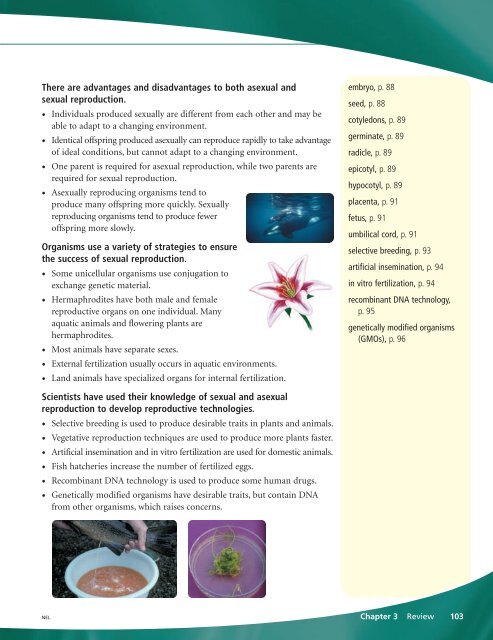Unit A Reproduction
Unit A Reproduction
Unit A Reproduction
You also want an ePaper? Increase the reach of your titles
YUMPU automatically turns print PDFs into web optimized ePapers that Google loves.
There are advantages and disadvantages to both asexual and<br />
sexual reproduction.<br />
• Individuals produced sexually are different from each other and may be<br />
able to adapt to a changing environment.<br />
• Identical offspring produced asexually can reproduce rapidly to take advantage<br />
of ideal conditions, but cannot adapt to a changing environment.<br />
• One parent is required for asexual reproduction, while two parents are<br />
required for sexual reproduction.<br />
• Asexually reproducing organisms tend to<br />
produce many offspring more quickly. Sexually<br />
reproducing organisms tend to produce fewer<br />
offspring more slowly.<br />
Organisms use a variety of strategies to ensure<br />
the success of sexual reproduction.<br />
• Some unicellular organisms use conjugation to<br />
exchange genetic material.<br />
• Hermaphrodites have both male and female<br />
reproductive organs on one individual. Many<br />
aquatic animals and flowering plants are<br />
hermaphrodites.<br />
• Most animals have separate sexes.<br />
• External fertilization usually occurs in aquatic environments.<br />
• Land animals have specialized organs for internal fertilization.<br />
Scientists have used their knowledge of sexual and asexual<br />
reproduction to develop reproductive technologies.<br />
• Selective breeding is used to produce desirable traits in plants and animals.<br />
• Vegetative reproduction techniques are used to produce more plants faster.<br />
• Artificial insemination and in vitro fertilization are used for domestic animals.<br />
• Fish hatcheries increase the number of fertilized eggs.<br />
• Recombinant DNA technology is used to produce some human drugs.<br />
• Genetically modified organisms have desirable traits, but contain DNA<br />
from other organisms, which raises concerns.<br />
embryo, p. 88<br />
seed, p. 88<br />
cotyledons, p. 89<br />
germinate, p. 89<br />
radicle, p. 89<br />
epicotyl, p. 89<br />
hypocotyl, p. 89<br />
placenta, p. 91<br />
fetus, p. 91<br />
umbilical cord, p. 91<br />
selective breeding, p. 93<br />
artificial insemination, p. 94<br />
in vitro fertilization, p. 94<br />
recombinant DNA technology,<br />
p. 95<br />
genetically modified organisms<br />
(GMOs), p. 96<br />
NEL<br />
Chapter 3 Review 103

















